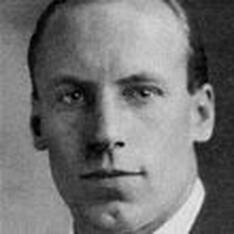
The Paris congregation of the Scots Kirk, was established in 1858; from then until the early 1880s services were held within the Oratoire du Louvre. Around 1883, the search began to look for a church building which might serve the Scots Kirk for generations to come. In 1885, the congregation moved its place of worship to the former American Episcopal church in rue Bayard. Then, as now, this was considered an ideal location, situated in the heart of Paris and a stone’s throw from Champs-Elysées.
From its beginnings in the 1850s, the Church of Scotland form of worship and other opportunities for fellowship and friendship have attracted many to rue Bayard. Some famous people have worshipped here. They include American President Woodrow Wilson, British Prime Minister David Lloyd George and Eric Liddell (right), the famous Scottish Olympic athlete (who preferred to preach in the Scots Kirk rather than race on a Sunday during the 1924 Paris Games). His life, missionary work and tragic death are recounted in the book and film "Chariots of Fire".
From its beginnings in the 1850s, the Church of Scotland form of worship and other opportunities for fellowship and friendship have attracted many to rue Bayard. Some famous people have worshipped here. They include American President Woodrow Wilson, British Prime Minister David Lloyd George and Eric Liddell (right), the famous Scottish Olympic athlete (who preferred to preach in the Scots Kirk rather than race on a Sunday during the 1924 Paris Games). His life, missionary work and tragic death are recounted in the book and film "Chariots of Fire".
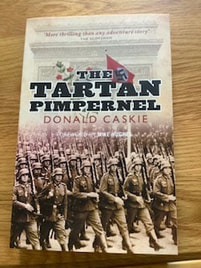
1940
In 1940, following the forced closure of the church due to the German occupation of Paris, Scots Kirk minister Donald Caskie moved to Marseille where he held services in the Seamen's Mission. He became a member of the French Resistance and a vital link in helping allied soldiers and airmen to safety in neutral Spain. Betrayed, arrested and sentenced to death by the Gestapo, his life was saved by a German pastor. His fascinating story is told in the book The Tartan Pimpernel and this link is one of which the Kirk is particularly proud.
Find out more about Donald Caskie, the Tartan Pimpernel.
In 1940, following the forced closure of the church due to the German occupation of Paris, Scots Kirk minister Donald Caskie moved to Marseille where he held services in the Seamen's Mission. He became a member of the French Resistance and a vital link in helping allied soldiers and airmen to safety in neutral Spain. Betrayed, arrested and sentenced to death by the Gestapo, his life was saved by a German pastor. His fascinating story is told in the book The Tartan Pimpernel and this link is one of which the Kirk is particularly proud.
Find out more about Donald Caskie, the Tartan Pimpernel.
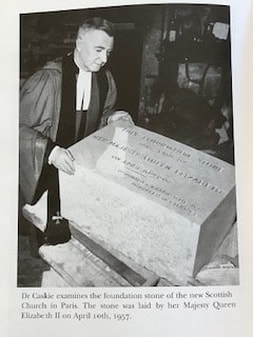
1950s
The original building was replaced by a new church in the late 1950s. Unfortunately it was beset by serious structural problems from an early date and by the 1980s it was obvious that it would require major repair or replacement.
In 1995 the Church of Scotland Board of World Mission decided to "sell" the site to a developer. They gave the developer the right to construct private apartments in return for demolishing the old church and providing the empty shell of the new. The daunting task of raising over £320,000 to transform this into a furnished and well-equipped church complex fell upon the congregation. Thanks to the support of members and friends throughout the world, the Development Appeal had raised over £250,000 by late 2002. The gap was bridged and final contractual bills settled by means of a loan from World Mission. The interest charges on the loan and repayment of the capital sum were a considerable financial challenge for the congregation but the loan was repaid in full in 2014.
The original building was replaced by a new church in the late 1950s. Unfortunately it was beset by serious structural problems from an early date and by the 1980s it was obvious that it would require major repair or replacement.
In 1995 the Church of Scotland Board of World Mission decided to "sell" the site to a developer. They gave the developer the right to construct private apartments in return for demolishing the old church and providing the empty shell of the new. The daunting task of raising over £320,000 to transform this into a furnished and well-equipped church complex fell upon the congregation. Thanks to the support of members and friends throughout the world, the Development Appeal had raised over £250,000 by late 2002. The gap was bridged and final contractual bills settled by means of a loan from World Mission. The interest charges on the loan and repayment of the capital sum were a considerable financial challenge for the congregation but the loan was repaid in full in 2014.
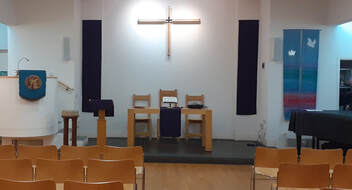
2002 - Present Day
Between autumn 1999 and 2002, services and other activities were held in the Eglise Réformée du Saint Esprit in rue Roquépine. The new Scots Kirk building was opened and dedicated in March 2002 by Rt Rev John Miller, Moderator of the General Assembly of the Church of Scotland. Its many attractive features reflect the excellent design work of architect Charles MacCallum. They include the external grill on which is mounted a Pictish Cross sculpted by Jacqueline Stieger, the Chancel Cross by the same artist, the Communion furniture, fine interior finish and excellent acoustics. The Communion Table and Chairs were funded by the Baird Trust and the Chancel Cross by the Hope Trust and Mr J McCormack-Turner; the cost of the pulpit was met by the wife and family of the late Rev David McKean, minister in Paris from 1975 - 1982.
Between autumn 1999 and 2002, services and other activities were held in the Eglise Réformée du Saint Esprit in rue Roquépine. The new Scots Kirk building was opened and dedicated in March 2002 by Rt Rev John Miller, Moderator of the General Assembly of the Church of Scotland. Its many attractive features reflect the excellent design work of architect Charles MacCallum. They include the external grill on which is mounted a Pictish Cross sculpted by Jacqueline Stieger, the Chancel Cross by the same artist, the Communion furniture, fine interior finish and excellent acoustics. The Communion Table and Chairs were funded by the Baird Trust and the Chancel Cross by the Hope Trust and Mr J McCormack-Turner; the cost of the pulpit was met by the wife and family of the late Rev David McKean, minister in Paris from 1975 - 1982.
FEATURES OF OUR CHURCH BUILDING AND SANCTUARY
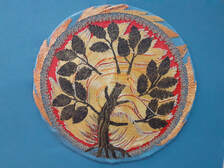
The Pulpit Fall
When the previous church building had to be pulled down at the end of the 1990s, the pulpit fall was worn, stained and generally in bad condition. It was renovated by Katie Matheson Hache, a talented tapestry weaver and member of the SKP congregation. She renewed the blue backing but was able to save the Burning Bush and the fringed border from the original pulpit fall and incorporate them into the new one which we can see in the church today.
When the previous church building had to be pulled down at the end of the 1990s, the pulpit fall was worn, stained and generally in bad condition. It was renovated by Katie Matheson Hache, a talented tapestry weaver and member of the SKP congregation. She renewed the blue backing but was able to save the Burning Bush and the fringed border from the original pulpit fall and incorporate them into the new one which we can see in the church today.
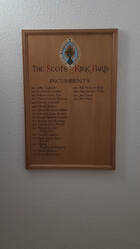
The Incumbents Board
The incumbents board is a relatively new addition to the Scots Kirk Paris. It is a much-appreciated gift from Stan Blacklock in remembrance of Rev. Donald Caskie whom Stan met in Paris in the 1950s while working as an Army nursing orderly. Donald Caskie introduced Stan to the Scots Kirk and he has been a faithful friend ever since.
We are grateful to Board member Elizabeth Sevo for her research into previous ministers of the Scots Kirk Paris and to elder Erwan Kucharski for having it made.
The Board hangs on the landing on the way down to the sanctuary.
The incumbents board is a relatively new addition to the Scots Kirk Paris. It is a much-appreciated gift from Stan Blacklock in remembrance of Rev. Donald Caskie whom Stan met in Paris in the 1950s while working as an Army nursing orderly. Donald Caskie introduced Stan to the Scots Kirk and he has been a faithful friend ever since.
We are grateful to Board member Elizabeth Sevo for her research into previous ministers of the Scots Kirk Paris and to elder Erwan Kucharski for having it made.
The Board hangs on the landing on the way down to the sanctuary.
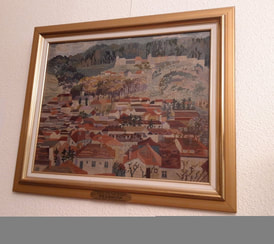
Besançon by Mary Stewart Gibson
This embroidery was donated to the Scots Kirk Paris by Mary Stewart Gibson who was a member of the congregation for many years until her death in 1989. Born in Longbridge, West Lothian in 1904, Mary studied at the Glasgow School of Art and then moved to Paris in 1923. She studied for three years under Emile Renard at the Ecole Nationale Supérieure des Beaux-Arts de Paris and regularly exhibited her work before and after the war in her Montparnasse studio, to critical acclaim. One French critic in 1932 described her as belonging to the school of Manet. Mary spent most of the Second World War in an internment camp in Besançon and she depicted her time there in a number of her works, of which this embroidery is an example.
This embroidery was donated to the Scots Kirk Paris by Mary Stewart Gibson who was a member of the congregation for many years until her death in 1989. Born in Longbridge, West Lothian in 1904, Mary studied at the Glasgow School of Art and then moved to Paris in 1923. She studied for three years under Emile Renard at the Ecole Nationale Supérieure des Beaux-Arts de Paris and regularly exhibited her work before and after the war in her Montparnasse studio, to critical acclaim. One French critic in 1932 described her as belonging to the school of Manet. Mary spent most of the Second World War in an internment camp in Besançon and she depicted her time there in a number of her works, of which this embroidery is an example.
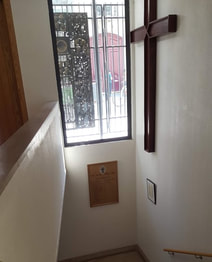
The Caskie Cross or "Paris Cross"
This cross was a gift from George Watson's Boys' College in Edinburgh in recognition of the hospitality offered by Donald Caskie to boys from GWBC participating in an annual exchange programme with the Lycée Henri IV in Paris. When asked how GWBC could contribute to the new church, the foundation stone of which was laid in 1958, Donald Caskie requested a cross to be hung behind the chancel table. A collection was organized in 1959 and each boy at the school contributed thrupence to fund the purchase of the "Paris cross".
When the present church was rebuilt and opened in 2002, it was decided not to use the cross and it lay in the cellar for 20 years. In 2018 the decision was taken to display it once again and it was officially re-inaugurated at a special service on 7th April 2019.
This cross was a gift from George Watson's Boys' College in Edinburgh in recognition of the hospitality offered by Donald Caskie to boys from GWBC participating in an annual exchange programme with the Lycée Henri IV in Paris. When asked how GWBC could contribute to the new church, the foundation stone of which was laid in 1958, Donald Caskie requested a cross to be hung behind the chancel table. A collection was organized in 1959 and each boy at the school contributed thrupence to fund the purchase of the "Paris cross".
When the present church was rebuilt and opened in 2002, it was decided not to use the cross and it lay in the cellar for 20 years. In 2018 the decision was taken to display it once again and it was officially re-inaugurated at a special service on 7th April 2019.
